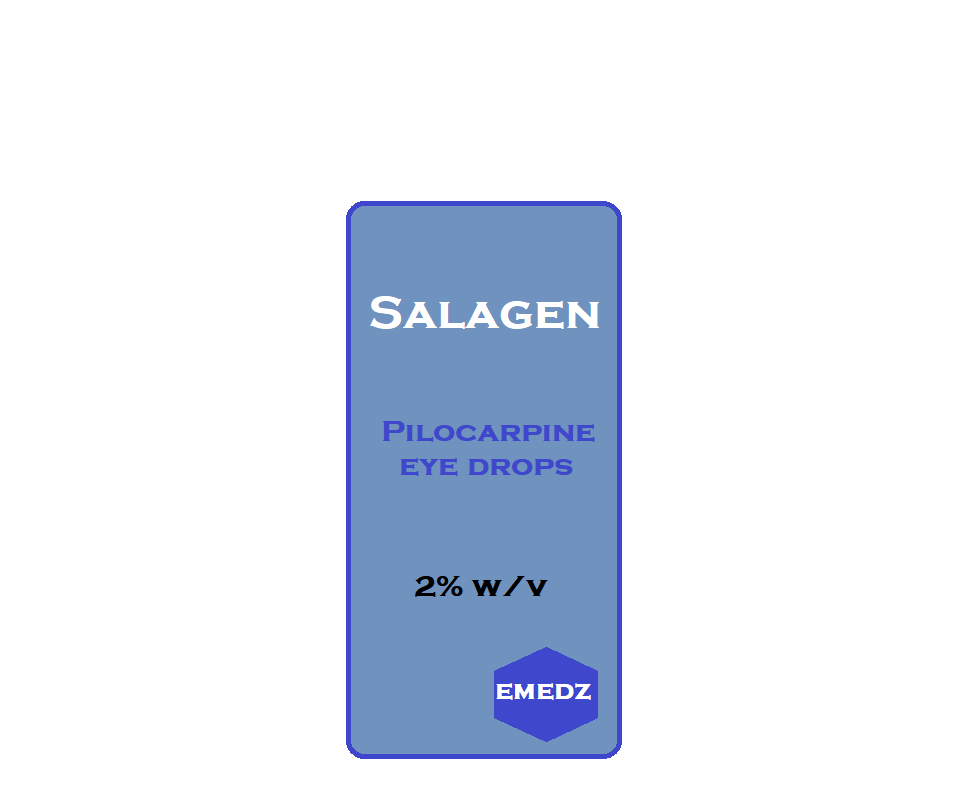Pilocarpine (ophthalmic) is a medication that is primarily used in ophthalmology, specifically for the treatment of certain eye conditions. It belongs to a class of drugs known as cholinergic agonists, and it works by stimulating the muscarinic receptors in the eye, which leads to constriction of the pupil (miosis) and an increase in the drainage of aqueous humor (the clear fluid inside the eye). These effects can be beneficial in the treatment of conditions such as glaucoma and certain types of intraocular hypertension.
Pilocarpine eye drops (Salagen) are a cholinergic receptor-activating drug that causes miosis when topically used in the eyes. This reduces resistance to the aqueous humor resulting in a reduction in the intraocular pressure in patients with angle-closure glaucoma.
Pilocarpine eye drops Uses:
- Elevated intraocular pressure:
- The following circumstances call for its usage to lower increased intraocular pressure (IOP).
- Angle-opening glaucoma
- When one of four prescribed drugs is administered to a patient with acute angle-closure glaucoma who can not be evaluated by an ophthalmologist for up to an hour (off-label use)
- either ocular hypertension
- The following circumstances call for its usage to lower increased intraocular pressure (IOP).
- Miosis:
- the beginning of miosis
- Prevention of postoperative elevated IOP:
- It is employed to stop postoperative IOP increase brought on by laser surgery.
Pilocarpine eye drops Dose in Adults:
Ophthalmic pilocarpine to treat elevated intraocular pressure, provide the following dose: Ophthalmic:
For open-angle glaucoma:
- You can use 1%, 2%, or 4% Pilocarpine eye drops in the affected eye up to 4 times a day. If you're new to using Pilocarpine, start with the 1% concentration.
- The specific strength of the solution and how often you use it will depend on how much your eye pressure is elevated and how well your eye responds to the medication.
For acute angle-closure glaucoma:
- In emergency situations when you can't see an eye doctor right away, you can use 2% Pilocarpine eye drops.
- Put one drop in the affected eye as part of a combination of four different eye medications.
- If the eye pressure is still too high (above 40 mm Hg) after 30 to 60 minutes, you can use another drop. However, it's essential to get to an eye specialist as soon as possible.
Pilocarpine eye drops Dosage in the therapy of Miosis:
Ophthalmic (Eye Drops):
- You can instill 1 drop of a 1%, 2%, or 4% Pilocarpine solution into the affected eye. Alternatively, you can use 2 drops, but space them 5 minutes apart.
Eye drops of pilocarpine To prevent postoperatively high IOP, take the following dose:
Ophthalmic (Eye Drops):
- Instill 1 drop of a 1%, 2%, or 4% Pilocarpine solution into the affected eye(s) 15 to 60 minutes before the surgery. Alternatively, you can use 2 drops, but space them 5 minutes apart.
Pilocarpine eye drops Dose in children
Eye drops of pilocarpine Dose for the treatment of high intraocular pressure and open-angle glaucoma:
For Infants and Children (Less than 2 years old):
- Use the ophthalmic 1% Pilocarpine solution.
- Instill 1 drop into the affected eye(s) 3 times a day.
For Children (2 years and older) and Adolescents:
- The choice of the Pilocarpine solution strength and the frequency of instillation will depend on the degree of pressure elevation and how well the patient responds to the medication.
- You can use the ophthalmic 1%, 2%, or 4% Pilocarpine solution.
- Instill one drop into the affected eye(s) up to 4 times a day. If the patient is new to using Pilocarpine, start with the 1% concentration.
Pilocarpine eye drops Dose in the therapy of acute angle-closure glaucoma:
For Infants and Children (Less than 2 years old):
- Use the ophthalmic 1% Pilocarpine solution.
- Instill 1 drop into the affected eye(s) 3 times a day.
For Children (2 years and older) and Adolescents:
- Use the ophthalmic 1% or 2% Pilocarpine solution.
- Initially, instill 1 drop into the affected eye(s) up to 3 times over a 30-minute period.
- In some cases, pretreatment with a secretory suppressant and a hyperosmotic agent may be needed to lower intraocular pressure (IOP) below 50 mm Hg and relieve iris ischemia.
- If laser iridoplasty or iridotomy is required to treat the condition, instill 1 drop of the 4% Pilocarpine solution before the procedure.
- After laser iridoplasty, use the 1% Pilocarpine solution, instilling 1 drop 4 times daily until an iridotomy can be performed.
Eye drops of pilocarpine Dose for Miosis Induction Prior to Trabeculectomy or Goniotomy:
For Infants and Children:
- Use the ophthalmic 1% or 2% Pilocarpine solution.
- Instill 1 drop into the eye(s) 15 to 60 minutes prior to the surgery.
For Adolescents:
- Use the ophthalmic 1%, 2%, or 4% Pilocarpine solution.
- Instill 1 or 2 drops, spaced 5 minutes apart, into the affected eye(s) prior to the surgery.
Pregnancy Risk Factor C
- Researchers have not done studies on how this thing (medicine or substance) affects the ability of animals to have babies.
Pilocarpine use during breastfeeding:
- We don't know for sure if Pilocarpine, when used in the eyes, is passed into breast milk.
- So, if a woman is breastfeeding, it's important to be careful when using Pilocarpine eye drops.
Dose in Kidney Disease:
- The information provided by the manufacturer doesn't include any specific adjustments to the dosage of this medication for individuals with kidney problems.
Dose in Liver disease:
- The manufacturer's labeling for this medication does not include specific dosage adjustments for individuals with hepatic impairment (liver problems).
Side effects of Pilocarpine eye drop:
- Gastrointestinal:
- Salivation
- Vomiting
- Diarrhea
- Nausea
- Cardiovascular:
- Tachycardia
- Hypertension
- Miscellaneous:
- Diaphoresis
- Ocular:
- Visual Acuity Decreased
- Corneal Granularity (Gel 10%)
- Burning
- Ciliary spasm
- Conjunctival Vascular Congestion
- Myopia
- Retinal Detachment
- Supraorbital Or Temporal Headache
- Lacrimation
- Lens Opacity
- Respiratory:
- Pulmonary Edema
- Bronchial Spasm
Contraindications to Pilocarpine eye drops:
U.S. Labeling:
- According to the U.S. labeling, there are no contraindications listed for Pilocarpine.
Canadian Labeling:
- In Canada, the use of Pilocarpine is contraindicated in individuals with hypersensitivity to pilocarpine or any component of the formulation.
- It is also contraindicated in conditions where pupillary constriction is undesirable, such as acute iritis and anterior uveitis.
Warnings and precautions
Ophthalmic effects
- When using this eye medication, be careful when driving or doing activities in low light.
- It might make your eyes less sharp, especially at night or in dim settings.
- Also, this type of medication can cause a condition where it's harder to focus on things up close.
- So, if you're driving at night or doing something that needs good eyesight, be cautious.
Asthma
- If you have asthma, be careful when using this medication.
Cardiovascular disease
- If you have cardiovascular disease, like recent heart issues, high or low blood pressure, or acute heart failure, use this medication cautiously.
- There's a note from the American Heart Association that suggests ophthalmic cholinergic agents, like this one, might have a minor effect on worsening underlying heart problems.
GI disease:
- If you have gastrointestinal (GI) issues like peptic ulcer disease or GI spasms, be cautious when using this medication.
Hyperthyroidism:
- If you have hyperthyroidism, use this medication with caution.
Ocular inflammation:
- If you have inflammation in your eyes, especially a condition called iritis, it's not recommended to use this medication.
- Also, it's advised to avoid using medications that constrict the pupil (miotics) in cases of acute inflammatory diseases in the front part of the eye.
Parkinson disease
- If you have Parkinson's disease, be cautious when using this medication.
Retinal disease
- Rare cases of retinal detachment (a serious eye condition) have been reported with this medication.
- If you are someone who might be more susceptible to this or if you already have an eye condition, be cautious.
- Before starting this treatment, it's recommended to have a thorough examination of your retina, including a test called funduscopy, to make sure your eyes are in good condition.
Occlusion of the urinary tract:
- If you have a urinary tract obstruction, be cautious when using this medication.
Pilocarpine(ophthalmic): Drug Interaction
|
Risk Factor C (Monitor therapy) |
|
|
Acetylcholinesterase Inhibitors |
may worsen the hazardous or harmful effects of cholinergic antagonists. |
|
Beta-Blockers |
may worsen the hazardous or harmful effects of cholinergic antagonists. The possibilities for bronchoconstriction and aberrant cardiac conduction are of special concern. Management: Use caution while combining these drugs, and keep an eye out for conduction issues. Because methacholine may cause further bronchoconstriction when used with any beta blocker, avoid using it. |
|
Cyclopentolate |
may lessen Pilocarpine's therapeutic effects (Ophthalmic). |
|
Risk Factor D (Consider therapy modification) |
|
|
Sincalide |
The therapeutic benefit of Sincalide may be reduced by medications that affect gallbladder function. Prior to using sincalide to induce gallbladder contraction, you should think about stopping any medications that can impair gallbladder motility. |
Monitoring parameters:
Intraocular Pressure:
- Check intraocular pressure 30 to 60 minutes after administering the medication.
- This is especially important for acute angle-closure glaucoma cases, according to studies (Pokhrel 2007; Weizer 2019).
Funduscopic Exam:
- Before starting the therapy, it's recommended to conduct a funduscopic examination.
- This examination assesses the back of the eye, including the retina and optic nerve.
Visual Field Testing:
- Consider visual field testing as part of the assessment.
- This test evaluates the full scope of what you can see, helping monitor any changes in your vision over time.
How to administer Pilocarpine eye drops?
After Administration:
- Gently apply finger pressure to the lacrimal sac for 2 minutes following the application of the medication.
Contact Lenses:
- Remove contact lenses before applying the eye drops.
- Wait 10 to 15 minutes before reinserting contact lenses.
Administration of Other Eye Medications:
- In most cases, if using other eye medications, administer them at least 5 minutes apart.
- For acute angle-closure glaucoma, separate administration of other eye medications by at least 1 minute (according to Pokhrel 2007 and Weizer 2019).
Avoiding Contamination:
- Do not touch the tip of the dropper to the eye, fingertips, or any other surface.
Mechanism of action of Pilocarpine (Salagen):
- It works by directly activating certain receptors in the eye.
- This causes the pupil to shrink (miosis) because the iris sphincter muscle contracts.
- It also makes it harder for the eye to focus up close (loss of accommodation) by constricting the ciliary muscle.
- Additionally, it lowers the pressure inside the eye by reducing resistance to the outflow of a clear fluid called aqueous humor.
Onset of Action:
- For making the pupil smaller (miosis), it usually takes between 10 to 30 minutes.
- To reduce intraocular pressure (pressure inside the eye), it typically starts working within 1 hour.
Peak Effect:
- The maximum impact of the medication is usually reached within 0.5 to 1 hour after administration.
Duration of Effect:
- The pupil-constricting effect (miosis) lasts for about 4 to 8 hours.
- The reduction in intraocular pressure can last anywhere from 4 to 12 hours.
International Brand Names of Pilocarpine eye drops:
- Isopto Carpine
- Isopto Carpina
- Odan-Pilocarpine
- Apicarpine
- Isopto Carpine
- Asthenopi
- Carpine
- Isopto Pilocarpina
- Liocarpina
- Locarp
- Isopto Pilocarpine
- Isopto-Carpine
- Medicarpine
- Miokar
- P.D.
- OcuCarpine
- Ocucarpine
- Ocusert Pilocarpine
- Oftan-Pilocarpin
- Ocusert Pilo-20
- Ocusert Pilo-40
- V. Carpine Liquifilm Ophthalimic Solution
- Pil Ofteno
- Pilo
- Pilocan
- Pilocar
- Pilocarpol
- Pilogel
- Pilogel HS
- Pilokarpin
- Pilomann
- Pilomin
- Pilopes
- Pilopine-HS
- Pilopos
- Pilopt Eye Drops
- Pilotina
- Pilotonina
- Sno Pilo
- Spersacarpin
- Spersacarpine
- Zhenrui
Pilocarpine eye drops Brand Names in Pakistan:
|
Pilocarpine Hydrochloride Nitrate Eye Drops 2 %w/v in Pakistan |
|
|
Medicarpine |
Medipak Limited |
|
Opta Carpine |
Remington Pharmaceutical Industries (Pvt) Ltd. |
|
Orbacarpine |
Zafa Pharmaceutical Laboratories (Pvt) Ltd. |
|
Pilocar |
Ethical Laboratories (Pvt) Ltd. |
|
Spersacarpine |
Novartis Pharma (Pak) Ltd |
|
Pilocarpine Hydrochloride Nitrate Eye Drops 4 %w/v in Pakistan |
|
|
Medicarpine |
Medipak Limited |
|
Opta Carpine |
Remington Pharmaceutical Industries (Pvt) Ltd. |
|
Pilocar |
Ethical Laboratories (Pvt) Ltd. |




